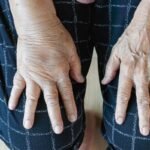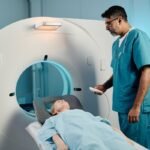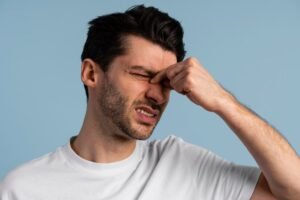Frontal fibrosing alopecia is an increasingly common type of hair loss. It typically affects menopausal women, but cases in younger women and men have increased in recent years.
This hair loss often has significant aesthetic consequences as it is a form of cicatricial alopecia. That is, the hair loss is irreversible.
It also tends to affect highly visible areas, primarily the hairline (on the forehead) and eyebrows.
For all these reasons, it is essential to know the early symptoms of frontal fibrosing alopecia so that treatment can be started as soon as possible.
The main symptoms of frontal fibrosing alopecia
In frontal fibrosing alopecia, the main symptom is usually hair loss at the hairline, that is, in what is known as the diadem area (frontotemporal region). Another common symptom is eyebrow alopecia.
Although less common, frontal fibrosing alopecia can also cause hair loss on the nape of the neck and even body hair.
Other typical symptoms are the presence of ” pimples ” on the face and prominent veins on the forehead.
Likewise, frontal fibrosing alopecia in men can also present with beard hair loss.
This disease progresses slowly over a few years and then, in some people, tends to stabilize.
As hair loss progresses, the receding hairline becomes increasingly noticeable. This hair loss sometimes occurs in a zigzag pattern, and bald spots may also appear.
To try to slow the progression of the disease, it’s key to know how to detect the symptoms of early frontal fibrosing alopecia. That is, before hair loss begins.
It is common for people to experience pain and/or itching on the scalp before noticing hair loss.
They may also develop a rash on their hairline, scalp, and face. These bumps can be red, yellow, or flesh-colored and are often scaly.
What causes frontal fibrosing alopecia?
The causes of frontal fibrosing alopecia are unknown. However, it appears to have an autoimmune and hormonal origin, and it affects genetically susceptible individuals.
It is believed to be an autoimmune disease because the body of people with frontal fibrosing alopecia attacks the hair follicles.
Specifically, it causes inflammation that, if not stopped, eventually destroys hair follicles. This leads to scarring, which prevents hair from growing back.
Regarding hormonal origin, it is believed that hormones play a key role in the development of frontal fibrosing alopecia.
The reason is that it is a much more common disease in women with premature menopause or who have had their uterus removed.
As for the genetic part, it has recently been shown that there are different genes that are involved in its appearance.
However, there are still many unknowns about why it occurs and what causes the progression of alopecia.
In this sense, the influence of some environmental factor cannot be ruled out.
What are the main risk factors?
Several factors can increase the risk of developing frontal fibrosing alopecia.
However, the presence of these characteristics does not necessarily mean that one will develop the disease. Similarly, it can occur in people without any risk factors.
Specifically, women in menopause are more likely to suffer from frontal fibrosing alopecia.
Similarly, having a family member with the disease is another important risk factor.
It has also been observed that this type of scarring alopecia is more common in those who suffer from rosacea, thyroid diseases (especially autoimmune hypothyroidism), and type 2 diabetes.
Although more research is needed, one study found that more than half of people with frontal fibrosing alopecia had another autoimmune disease, including hypothyroidism, vitiligo, and lupus.
Hair loss due to stress is a well-known phenomenon, but its implications for this type of alopecia are unclear.
Even so, it is believed that it could be a risk factor in people who are predisposed to suffering from this disease.
Is there a cure for frontal fibrosing alopecia?
Currently, frontal fibrosing alopecia has no cure. However, the sooner alopecia is diagnosed and treatment is started, the better the results will be.
In this sense, there are different treatments that, in many cases, manage to stop or at least slow its progress.
The goal is to stabilize hair loss until the disease stops on its own. This way, the hair that has not yet been lost can be preserved.
Sometimes, it is even possible to achieve an improvement in hair density at the hairline.
The best treatments for frontal fibrosing alopecia
For frontal fibrosing alopecia, treatment often combines different therapeutic options (oral, topical, and injected). Furthermore, when hair loss has already occurred, cosmetic measures may also be included.
The most important thing is that the dermatologist can make a good differential diagnosis. This is key because the disease can often occur alongside other types of diffuse alopecia (such as androgenetic alopecia ), alopecia areata, or traction alopecia.
Among the treatments for frontal fibrosing alopecia, these tend to be the most common.
Finasteride
Various studies have shown that treatment with 5-α-reductase inhibitors, finasteride and dutasteride, helps prevent hair density loss.
Some people with frontal fibrosing alopecia even experienced mild new hair growth thanks to these drugs.
Corticosteroids
To reduce the inflammation caused by frontal fibrosing alopecia, intralesional corticosteroid injections can be used in the scalp or eyebrows, especially when the condition is accompanied by itching, erythema, and hyperkeratosis (thickening of the skin).
Topical corticosteroids may also be prescribed for use at home.
In the case of frontal fibrosing alopecia of the eyebrows, the vast majority of people experience partial or complete improvement with treatment.
Oral antimalarials
Chloroquine and hydroxychloroquine are also effective therapeutic alternatives for the treatment of frontal fibrosing alopecia.
Although they have shown less efficacy than previous drugs, they can be used as adjuvant therapy.
Treatment for frontal fibrosing alopecia usually includes different types of medications, as well as cosmetic measures.
Minoxidil
Low-dose oral minoxidil is another off–label adjunctive therapy for frontal fibrosing alopecia.
A recent study found that it improved overall hair and eyebrow growth, as well as improved the density of the frontotemporal hairline.
Improvements have also been seen with the combination of finasteride and topical minoxidil.
Calcinuerin inhibitors
Topical calcineurin inhibitors, drugs used in diseases such as atopic dermatitis, may be another adjuvant alternative.
Drugs such as tacrolimus and pimecrolimus have shown mild efficacy in early frontal fibrosing alopecia due to their anti-inflammatory effect.
Regardless of the treatment for frontal fibrosing alopecia, it’s important to keep in mind that results aren’t immediate. Improvement can usually be seen within 6 to 18 months.
Once hair loss has occurred, cosmetic treatments can also be used, especially if the condition is causing significant cosmetic discomfort or self-consciousness.
Among them, hair fibers, micropigmentation, eyebrow microblading, and hair prostheses stand out.
Hair transplantation is not usually an option for treating the progression of frontal fibrosing alopecia. It may only be considered when the disease is stabilized, there is no inflammation, and it affects only small areas.
However, it should be noted that transplanted hair may be lost within a period of 2 to 3 years.
Regarding the latest developments in frontal fibrosing alopecia , these are promising and involve the use of new treatments. These include immunosuppressive drugs, stem cell therapies, and low-level laser therapy.
Frontal fibrosing alopecia, nutrition and natural treatments
The relationship between frontal fibrosing alopecia and diet has been the subject of extensive study by dermatologists. However, to date, no study has shown that certain foods or diets help slow the condition or promote new hair growth.
Even so, nutrition has an impact on overall health, as well as on hair health. Therefore, it’s always a good idea to incorporate foods and vitamins that contribute to healthy hair into your diet.
In the case of frontal fibrosing alopecia, it’s essential to use gentle, fragrance-free facial and hair care products. The goal is to prevent further inflammation of the skin and scalp.
The use of hair dryers, flat irons, and curling irons that generate heat should also be limited.
For people with frontal fibrosing alopecia, natural treatments can be very tempting. However, these are ineffective and often delay the start of medical treatment.
In this regard, it is worth remembering that the earlier treatment is given, the greater the chances of achieving a reversal of the progression of alopecia.























+ There are no comments
Add yours